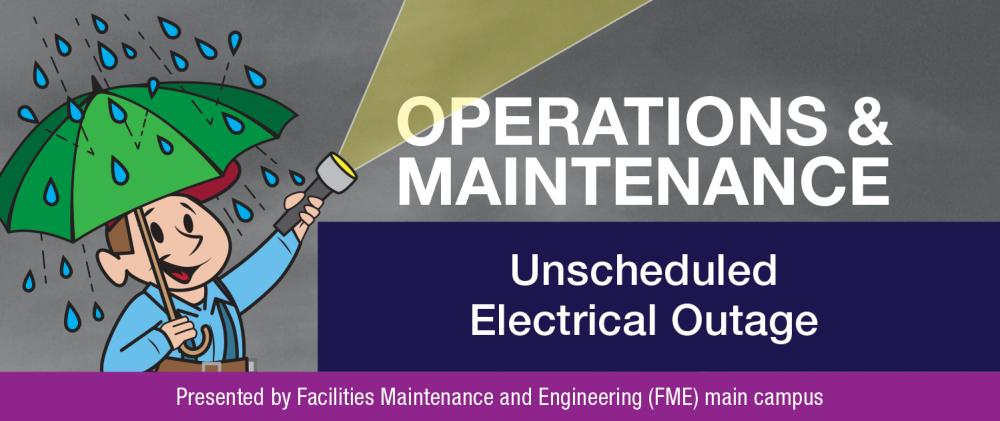Occurring without notice, unscheduled utility outages (mainly electrical) are abrupt and create a nuisance. During an unscheduled electrical  power outage, the Operations and Maintenance (O&M) department will monitor stand-by generators for proper operation. During the outage, the critical equipment identified for connection to the generator should be operating. These “loads” are evaluated for the safe operation of the generator and are used to calculate the generator run time. Please do not ask for extension cords during this type of outage; emergency outage procedures should already be in place. Additional loading of the generator without proper evaluation could jeopardize the generator and operation of the predetermined critical equipment.
power outage, the Operations and Maintenance (O&M) department will monitor stand-by generators for proper operation. During the outage, the critical equipment identified for connection to the generator should be operating. These “loads” are evaluated for the safe operation of the generator and are used to calculate the generator run time. Please do not ask for extension cords during this type of outage; emergency outage procedures should already be in place. Additional loading of the generator without proper evaluation could jeopardize the generator and operation of the predetermined critical equipment.
 In an unscheduled power outage, all interior lights will go out except the emergency lighting system. Secure your work area; ensure that your refrigerator, freezer, and incubator doors are closed, and report to the designated gathering area outside of your building for further instructions. The emergency lighting will provide temporary lighting for your evacuation. Aisles, exits, and entrances are to be kept clear and unobstructed to avoid tripping and falling. Do not use elevators. Take the stairs instead. Passengers who find themselves in elevators that have unexpectedly stopped during a power outage should use the emergency phones, which are linked to Protective Services, to call for help. Do not attempt to climb out!
In an unscheduled power outage, all interior lights will go out except the emergency lighting system. Secure your work area; ensure that your refrigerator, freezer, and incubator doors are closed, and report to the designated gathering area outside of your building for further instructions. The emergency lighting will provide temporary lighting for your evacuation. Aisles, exits, and entrances are to be kept clear and unobstructed to avoid tripping and falling. Do not use elevators. Take the stairs instead. Passengers who find themselves in elevators that have unexpectedly stopped during a power outage should use the emergency phones, which are linked to Protective Services, to call for help. Do not attempt to climb out!
At the return to “normal” electrical power, the O&M department will restore utility systems in a prioritized manner. Animal facilities have the highest priority to ensure the well-being and care of our animal population. Once the animal facilities are restarted and operating, the O&M department will focus on restarting the repository and laboratory buildings followed by the remaining administrative buildings.
Safety Tip
For personal emergency lighting, it is recommended to use battery-powered lighting or flashlights during a power outage. Candles and lanterns use flames, which can potentially cause fires. The National Fire Protection Association (NFPA) reported that during 2011–2015, U.S. fire departments responded to an estimated 8,690 home structure fires each year that were started by candles. These fires caused 82 deaths, 800 injuries, and $295 million in direct property damage.
Click the following link for additional in-depth information about FME: https://ncifrederick.cancer.gov/services/fme
Contact the Help Desk
E-mail: fmetrbldsk@nih.gov
Phone: 301-846-1068




